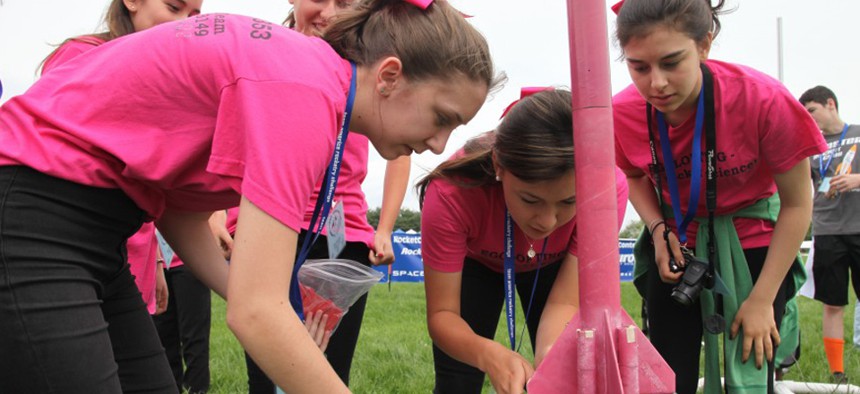These Teenage Girls Are Ready to Change the Male-Dominated Aerospace Industry

A team of girl scouts from the San Gabriel Valley in California, were one of the few all-girl teams. Team America Rocketry Competition
Currently, only 24 percent of aerospace professionals are women.
Kelsey Webb is a long way from her small town in South Texas.
The 14-year-old freshman from Three Rivers stands confidently in a sea of hundreds of science students packed into a warm room near the Capitol on this muggy May morning. She's displaying the pink-and-white rocket that her team spent nine months building. The next day brings the real task: the Team America Rocketry Challenge, the world's largest rocketry competition.
Two things stand out about Webb. The first is her rocket. It's hard to tell the difference between the dozens of rockets designed by hundreds of middle and high school students to fly 825 feet and land safely with two eggs inside. But her team's rocket has the signatures of the town's 20 breast-cancer survivors—a touching tribute to their small community of 1,800 people.
The second is that she's a girl. "Hard work and right attitude," Webb says are what got her here today. But a look around the room shows the challenges of a boy-filled competition for a field dominated by men.
The room, in many ways, reflects the aerospace field overall. Just 24 percent of aerospace professionals are women, according to a 2013 Aviation Week Workforce Study. Worse, a University of Wisconsin (Milwaukee) study found that only 11 percent of practicing engineers are women.
Science, technology, engineering, and mathematics industries have a gender-gap issue, and aerospace is not immune. And that fact bothers Kara Chuang, a 16-year-old sophomore on a team from the San Gabriel Valley in California, standing among other competitors in the Hart Senate Office Building.
"By doing competitions like this, by promoting STEM, it introduces girls into a mainly man-dominant field," said Chuang, who is on a team filled with fellow Girl Scouts. "We can do just as well as them."
"We can do just as well as them."
Chuang is a member of one of the few all-girl teams at the competition. Her teammates stand around her, all confident in their career hopes and with the knowledge they deserve to be there. While there are science programs in their schools and they were able to compete here, they also acknowledge that not everyone has those opportunities.
Her teammate Hannah Kim wants to fix that. "Women don't have as much access to these fields in general," the 15-year-old freshman chimes in. "What we'd like to do is open up programs in public schools that will help students learn about these competitions and choose based on their interests."
Kim wants to be an aerospace engineer one day, but she's one of the few who actually do. According to that same Aviation Week study, just 12 percent of engineers in the aerospace industry are women.
The problem for many of these girls is not a lack of funding in aviation programs. Rather, it's a lack of corporate outreach to children at early enough stages in their education.
Susan Lavrakas, director of workforce for the 336-member Aerospace Industries Association (one of the event's sponsors), says this is her priority. She wants to get girls and women in STEM subjects and recruit them into their industry.
"We are very frustrated. Those are not acceptable numbers," Lavrakas said. "We need to reach girls when they're in elementary school. By the eighth grade, they've already made choices or are making choices that would make it impossible for them to pursue an engineering degree."
Lavrakas, who has been in the aerospace industry for 32 years, said her organization is focusing on new metrics and best practices to change the way the industry allocates funds to programs that actually work and reach women at the right ages.
"Even though our companies collectively dedicate an excess of $160 million a year, we feel that we're not seeing a return on that investment," she continued. "Statistics nationally are not changing significantly."
"We are very frustrated. Those are not acceptable numbers."
Just last year, there was a 30 percent increase in women studying engineering. But there's a difference between getting women to study in the field and getting them to actually practice it. While 20 percent of engineering graduates are women, just over 10 percent work for related companies.
Another concern for the aerospace industry is that women are leaving early, citing lack of advancement and hostile working environments. A Catalyst industry report shows that 41 percent of women leave aviation after 10 years. Just 17 percent of men do the same.
Webb's team and the team of Girl Scouts didn't end up winning the competition that took place 45 minutes outside of Washington, shooting rockets into the cloudy Saturday sky. But just by being there, maybe they can inspire other girls to find their calling in an industry that can one day be their own.
Reena Flores contributed to this article.
NEXT STORY: VA waiting lists and performance measurement


